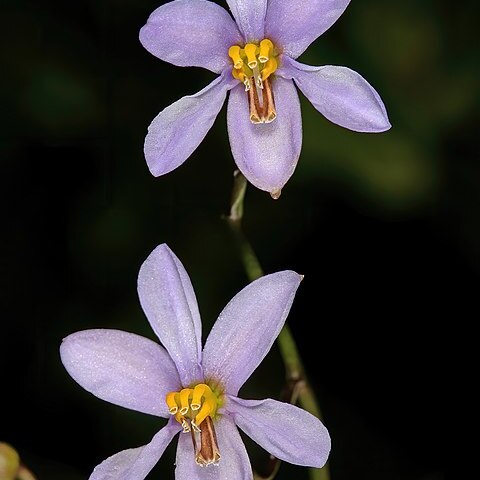Plants 150-400(-500) mm high. Corms deep-seated, 25-30 mm diam., tunics of coarsely netted, wiry or woody fibres, not or extending shortly into a fibrous neck to 20 mm long, pale brown or grey. Basal leaves 4-9(-12), suberect or spreading, linear to narrowly lanceolate, 60-200(-250) x (2-)4-15(-25) mm, acute to attenuate, plane, canaliculate or rarely involute, with prominent midrib and ribbed veins abaxially, firm-textured, usually glabrous but veins sometimes scabridulous or puberulous to villous abaxially with hairs up to 1 mm long, rarely both surfaces densely puberulous thoughout, margins ± undulate or crispulate, usually ciliolate-scabridulous, sometimes flushed purple basally. Inflorescence a moderately dense raceme up to 25-flowered, with 2-4 branches, rarely with second order branchlets and thus paniculate, lower flowers 0.3-0.6 times pedicel length apart; pedicels usually geniculate, horizontal in basal 1/2 or 2/3 then aburptly flexed upwards at ± right angles, rarely suberect or arcuate, mostly 20-30 mm long; bracteoles mostly inserted between lower and upper third, rarely subbasal. Flowers facing outwards, pale to deep mauve or blue, rarely white or pink, fragrant; tepals spreading, ovate to obovate, 8-10 x 3-4 mm, apiculate. Stamens dimorphic, 5 + 1; filaments of posterior cluster 1.0-2.5 mm long, outer sometimes slightly longer than inner, connate ± halfway or almost completely into tube 1.0-2.0 mm long, yellow, sometimes with small intrastaminal lobules between bases of filaments, anthers 1.5-2.0(-2.8) mm long, yellow; anterior stamen with filament ± 1 mm long, connate to upper cluster for ± half length, anther 2.5-4.0 mm long, yellow. Ovary half inferior, style medially deflexed, 3-4 mm long, not extending beyond anthers. Capsules erect on geniculate pedicels, subglobose, 5-6 mm diam., 3-lobed and retuse. Seeds ovoid, ± 2 mm diam., rugulose.
More
Annual or perennial herb with globose corm; neck of corm 7–15 cm long; leaves and inflorescence annual. Leaves 6–8, linear, 15–30+ cm long. Inflorescence an openly branched raceme to 40 cm high; bracts lanceolate; pedicels curved, to 2.5 cm long. Flowers slightly zygomorphic. Perianth segments oblong, 6–12 mm long, white, pale violet, pink or lilac-purple. Sepals 5-nerved. Petals 3-nerved. Stamens yellow, dimorphic, 5 curved with anthers 1.5–2 mm long and 1 declinate with large sessile anther c. 3 mm long. Style equal to anthers. Capsule globose.
Cormous geophyte, 250-400 mm tall. Leaves linear to lanceolate, glabrous to finely pubescent. Flowers on ± horizontally spreading pedicels in a dense raceme, blue or mauve, rarely white, zygomorphic, fragrant, tepals 8-10 mm; anthers yellow, 5 upper and 1 larger lower, filaments connate ± halfway, sometimes with minute inter-staminodal teeth.
A herb. It develops a corm. It can grow as an annual or keep growing from year to year. It grows 15-35 cm high. There are several slender leaves develop from the corm. The corm has a long neck. The flowers are white, pink, purple or lilac. They have a scent. There are 5 small stamen above and one large stamen below.
Cormous geophyte, 25-40 cm. Leaves linear-lanceolate, smooth to finely or roughly hairy. Flowers in branched racemes, mauve, sometimes white, stamens bright yellow, fragrant, pedicels geniculate, with 5 upper and 1 larger lower stamen, filaments fused ± halfway.
In Australia recorded growing in sandy soil, peaty sand, ironstone gravel, on hillside, road verges, in coastal dunes and at the edge of a woodland.
More
It grows in warm temperate places. It grows on black peaty sand and dunes. It can grow in arid places.
Mostly found on clay and granite slopes, often in renosterveld.

